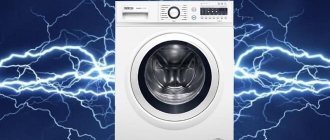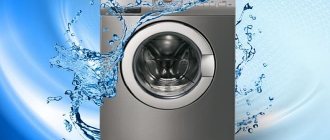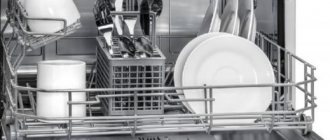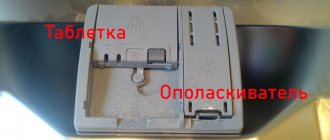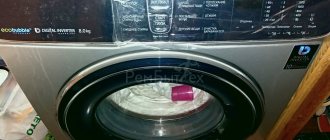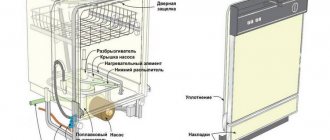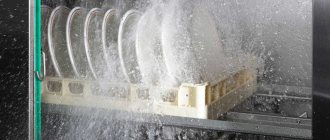The dishwasher saves not only the user’s personal time, but also water. Considering the current cost of the resource, we must recognize the feasibility of using this kitchen appliance, because... it uses very little water compared to manual washing.
- What is the water consumption of a dishwasher?
- How savings are achieved
- Comparison with hand washing
- Calculation of savings in money
- Expert advice
- Dishwasher catalog with reviews
What is the water consumption of a dishwasher?
The range of dishwashers presented by different manufacturers includes narrow, compact and full-size options that differ, among other characteristics, in chamber capacity. We can say that water consumption depends on this indicator.
For 60 cm
Full-size dishwashers can clean 10 to 14 sets of dishes in one cycle and use 9-14 liters of water. Some expensive full-size PMMs consume only 6.5-7 liters, depending on technical capabilities.
A small family should not purchase a machine with a large chamber, so as not to waste excess water. Having dirty dishes pile up for days is not very pleasant, and it can also lead to a bad smell in your car.
hio 3c23 wf
For 45 cm
As a rule, water consumption in narrow PMM models of different brands is small - up to 9 liters per working cycle. This technique can accommodate up to 9 sets of dishes and consumes 0.69 kWh during the normal program, which lasts an average of 205 minutes.
Compact PMM
The washing chamber of compact dishwashers can accommodate 6-8 sets of dishes. At the same time, the machines consume the same amount of water as narrow or full-size economical versions - 6.5-9 liters. It turns out that the same amount of resources is consumed, and less dishes are washed.
But still, consumption depends to a greater extent on such design characteristics as efficiency than on dimensions and capacity. The more efficiently a technology saves resources, the higher its cost.
4 SKS62E88
By mode
Water consumption during machine washing depends on the selected program. The half-load mode allows you to reduce water costs by 20-30%.
The function of intelligent load assessment, provided in the premium PMM, is that the device automatically determines the required volume of water depending on the amount and degree of soiling of the dishes.
Manufacturers equip their equipment with different programs and options, but water is consumed approximately as follows:
- “Light pollution” will require 7 liters.
- In “Economic” mode, 8-9 liters will be spent.
- The “Auto” option assumes consumption of 6-11 liters.
- With “Intensive” washing, resource costs will increase to 10-11 liters.
Have you set the water hardness in PMM?
Yes, of course. No.
By brand
Each manufacturer produces PMMs with different characteristics, but in general all companies strive to minimize water costs using innovative solutions. If we summarize the performance of dishwashers of different brands, the average water consumption of the appliance can be represented as follows:
- Bosch - about 10 l;
- Siemens – 7 l;
- Candy – 8-13 l;
- Beko – up to 12 l;
- Electrolux – up to 10 l;
- Indesit – 7 l.
- Ariston - 8-10 l.
hsie 2b19
What does consumption depend on?
The cost-effectiveness of technology depends on the manufacturer - its scientific and technical capabilities, which allow the creation of progressive and knowledge-intensive modifications. Depending on the level of liquid consumption, dishwashers are distinguished:
- highly economical;
- moderately economical;
- uneconomical.
Also, PMMs are divided into classes based on efficiency - from A to G. Popular brands - Bosch, Candy, Electrolux and others, produce only highly economical models of classes A - C. Uneconomical versions are no longer produced in Europe, and their import is prohibited.
How much liquid the device takes per cycle is an indicator not regulated by standards. The water consumption class is affected by:
- design solutions used in a specific modification;
- availability of additional functions.
All modifications can be divided into 3 groups:
- Household appliances are full-size and narrow. They spend 9–14 liters.
- Compact - 6.5–10 l.
- Large devices. The consumption of professional dishwashers installed in catering outlets is 20–25 liters.
How savings are achieved
The dishwasher uses water more economically thanks to the following operating features:
- The water in the device is reused many times, purified using filters.
- Water is sprayed under high pressure.
Water in the PMM is used at three stages:
- pre-spraying;
- main washing cycle;
- rinsing.
After completing the first operation, the machine does not drain the water into the sewer, but passes it through a filtration system and reuses it. After washing dirty dishes, the equipment partially drains the liquid and adds a fresh portion from the water supply to the remainder.
Expert opinion
I work in the household appliance repair industry. Extensive experience in restoring washing machines and dishwashers.
Ask a Question
Thanks to the high flow rate of water from the sprinklers, the quality of washing dishes is improved and the process is accelerated, as well as resource consumption is reduced.
Advantages and disadvantages
In addition to saving water, dishwashers have many other advantages, but there are also disadvantages. Let's look at them.
Advantages
When washing dishes in the dishwasher, the water temperature often reaches +75…90 ℃. Thanks to this, the sterility of kitchen utensils is achieved, which will especially appeal to mothers with small children, for example.
In addition, the quality of washing dishes in a dishwasher is many times higher than by hand. This depends not only on special detergents, but also on the very high temperature of the water in the dishwasher. In addition, it has been proven many times that dishwashers save their owners time over the course of a year, which can be compared to a person’s labor for a month.
Washing dishes by hand wastes much more water than using a machine.
You should know that a dishwasher can be used to wash more than just dishes. Gas burners from stoves, barbecue grills, baking dishes and much more can also be easily washed with its help without wasting your time and effort.
Flaws
When making a choice in favor of one model or another, be sure to think about how many dishes you expect to use per load. By purchasing a full-size model for a small number of people, you risk turning your new kitchen assistant into a warehouse for unwashed dishes, which will also smell bad.
Don't turn your appliances into storage for unwashed dishes
Sometimes the dishwasher will have to be cleaned and washed. You will need to run idle cycles periodically to perform the self-cleaning process. You will also need to clean the pump and filters occasionally.
Those who previously considered a dishwasher a luxury item sooner or later change their minds, especially when they see lower numbers on the meter and lower water service charges. Of course, a dishwasher will help save money, time and effort for the whole family.
Comparison with hand washing
In addition to the fact that the dishwasher uses water repeatedly and therefore consumes a small volume, the device only draws cold water for its operation, heating it to the desired temperature. This solution is cheaper for the user.
Even if you take into account the energy consumption for heating, this method will still be cheaper than using hot water. In addition, hot water from the tap is dirtier; its impurities can quickly clog PMM filters.
Practice shows that when washing the same volume of dirty dishes, a machine consumes 10 times less water than the housewife using the manual method. At the same time, self-washing involves the use of more expensive hot water.
Is a dishwasher profitable?
Oh yes! No
When washing dishes by hand, up to 100 liters of mixed water goes down the drain. The appliance will clean the same number of kitchen utensils, spending approximately 10 liters. Consumption depends on the model and selected mode.
Experts believe that a dishwasher pays for itself within 4 years on average. Household appliances stores regularly hold promotions and make attractive offers to customers.
Features of free-standing dishwashers
Why Bosch? The answer is simple. It is this manufacturer that monitors the quality of all its products, provides a guarantee and stuffs its devices with the latest functions that will significantly simplify your life and save time.
The main pleasant functions of Bosch dishwashers:
- “VarioSpeed” is a useful feature that allows you to speed up dishwashing time by 20-60 minutes at the touch of a button. The option is not a new product; almost all modern manufacturers can boast of its presence. Despite this, only Bosch dishwashers can guarantee you excellent results and clean dishes even if they are heavily soiled;
- “Aqua-Stop” - the presence of this option means that you no longer have to worry about water overflow or leakage. The water is shut off both when turned off and in case of unforeseen circumstances or failure of the device;
- brushless inverter motor EcoSilence Drive , which is equipped with all Bosch dishwashers. When manufacturing the engine, the latest developments of the manufacturer were taken into account; modern equipment with permanent magnets was used. Machines equipped with such a motor are 20% quieter and consume 30% less electricity;
- “AquaSensor” is a sensor with an automated system for checking water transparency. The work is carried out thanks to a photocell, which is activated during the pre-rinse. If the water passes the test, the machine reuses it. Thanks to this option, you will receive a reduction in energy consumption, perfectly clean dishes and can save up to 5 liters of water.
Calculation of savings in money
The annual water consumption for washing dishes is as follows:
- in the car - 10 l * 365 days = 3650 l of cold water;
- manually – 100 l * 365 days = 36500 l of mixed water.
Let's assume that the cost of a cubic meter of resource in the user's region is:
- cold water supply – 20 rub./m³;
- hot water supply – 70 rub./m³.
Let's calculate the annual water consumption in monetary terms:
- PMM – 3,650 m³ * 20 rub./m³ = 73 rub.
- Manual washing – 36,500 m³ * 70 RUR/m³ = 2555 RUR.
Obviously, using kitchen appliances brings big savings. This calculation does not take into account the difference in the cost of detergents: tablets, rinse aid and special salt for water softening.
Expert advice
When choosing a dishwasher in a store, pay attention to such indicators as:
- washing class;
- Economy mode and half load option available.
The operation of class A appliances is characterized by the lowest water consumption. According to this indicator (from A to G), dishwashers are divided into:
- economical;
- average degree of efficiency;
- low-cost.
In recent years, kitchen appliance manufacturers have been producing devices that use water resources as efficiently as possible.
Special modes will help reduce the amount of water consumed:
- economical;
- for light contamination;
- half load.
Remember also that proper placement of dishes will ensure ideal washing results and make it possible to reduce water consumption. Recommendations for the distribution of kitchen utensils in the washing compartment can be found in the user manual.
There are many benefits of using a dishwasher in your home. In addition to saving time and the ability to go about their business, the user receives a reduction in water consumption. The technology uses an expensive resource efficiently and repeatedly.
Advantages of dishwashers
The general design of all models is similar: two or three baskets for dishes, various trays for cutlery. All modern models are equipped with a heating element. Thus, the presence or absence of hot water will not affect the result in any way.
This can already be considered a beneficial advantage, because the tariff for cold water is several times lower.
Dishwashers have filter elements through which the same volume of water is used several times. Achieving such a result manually is very difficult. Some models are equipped with a “half load” or “auto mode” function; the washing cycle may not change in time, but the water consumption will decrease by about a quarter.
In addition, there is another class of water consumption of cars:
- highly economical;
- medium-economical;
- low-economical.
According to standards, the class is marked with the letters A, B and C, respectively. Most models, of course, go under class “A”, but when choosing a suitable car for your home you should pay attention to this parameter.
